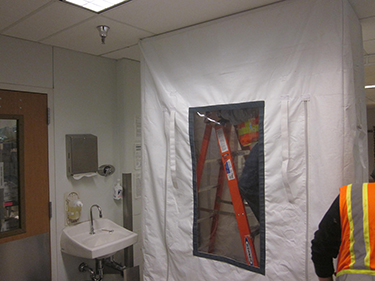|
Subscribe / Renew |
|
|
Contact Us |
|
| ► Subscribe to our Free Weekly Newsletter | |
| home | Welcome, sign in or click here to subscribe. | login |
Construction
| |
 |
July 24, 2014
What’s next for the UW medical center
Mortenson Construction

Baughman
|
The second phase of the $93 million University of Washington Medical Center project consists of a series of interior renovations in Pacific and Muilenburg towers, as well as infill of shell space in Montlake Tower. Also, the central utility plant will receive a new generator and chiller.
The project team consists of NBBJ as the designer and Mortenson Construction as the GC/CM, with MacDonald-Miller as MC/CM and Cochran as EC/CM for all phases of work.
A construction start ceremony was held in June. The first phase, which involved the construction of the 273,000-square-foot Montlake Tower, was completed in 2012.
Planning ahead
The UWMC project poses several challenges including complex phasing and proximity to patients and sensitive areas of the hospital. Construction will take place next to high-risk patients, creating even more need for pre-planning and infection-control management.
To address these challenges, the project team utilized technology tools including building-information modeling (BIM) to pre-plan the work and ensure certainty in scheduling and planning.
The team is utilizing laser scanning of existing slabs to evaluate and remediate floor flatness and evaluate above-ceiling conditions for feedback into the coordinated BIM model. Three-dimensional coordination of systems, including clash detection with existing construction and necessary maintenance areas prior to construction, will alleviate any schedule delay due to unknown conditions.
Through use of the fully coordinated 3-D model, the team is able to create and install prefabricated components including headwalls and multi-trade racks.
Due to limited laydown, storage area, and minimized construction work in the high-risk areas of the hospital, the team is driving to complete as much work away from the job site as possible to minimize the impact on patients and staff.
The team will install “multi-trade racks” in the corridors of the Montlake bed floors. These are fabricated steel racks in which mechanical and electrical components are installed off site and then delivered as a prefabricated unit. The team will also prefabricate headwalls off site and pre-install hardware on doors prior to delivery.
Extensive noise testing for construction activities is being completed prior to the start of construction in any area. The testing ensures noise control expectations are met and allows the team and owner to evaluate if different scheduling is needed prior to beginning construction of that activity.
The UWMC project is being designed and constructed in several overlapping phases, referred to as design packages. The last of the phases are scheduled to finish in November 2017.
Design package 1
Valued at $7 million, design package 1 includes renovation of several occupied and functioning portions of the existing hospital, including an inpatient cancer treatment bed floor, an outpatient cancer treatment clinic, renovations at the inpatient psychiatric unit and construction of an anticoagulation clinic.
The oncology spaces will be completed in phases to allow continued patient care during construction, and when complete, will also provide critical patient transport access between the existing cancer treatment services in Muilenburg and Montlake towers.
The renovations at the inpatient cancer treatment bed floor will modify mechanical systems to significantly enhance patient comfort, provide an improved patient care environment and upgrade several areas of provider space to improve staff satisfaction.
Patient care dictates that no more than 10 beds can be out of service at one time, so the construction work will be completed in four coordinated phases to eliminate duplicate periods of patient care disruption. Occupied rooms have patients with significantly compromised immune systems, making the infection-control planning and implementation a key factor in the process of this construction.
Room-by-room renovations at the inpatient psychiatric floor, including significant demolition, make this portion of construction exceptionally complex. Access into and out of the construction areas is difficult, carefully planned and tightly controlled.
In addition, the specific needs of the patients adjacent to the work dictate that noise-generating activities happen at only specific times during the day, and crews must be prepared to stop work in deference to patients’ needs. The construction schedule must be flexible to accommodate patient care.
An existing outpatient anticoagulation clinic is being replaced in a later phase but must remain functional during the entire construction process. The new anticoagulation clinic needs to be constructed prior to the work in the later phase. This “make ready” project will be built near the hospital’s busy main entrance on the third floor.
Design package 4
The largest of the phases, design package 4, includes buildout of spaces within the recently completed Montlake Tower that were left unfinished during the first phase of the project. This phase of work is valued at approximately $53 million.
The package includes construction of two floors of intensive care unit beds and one floor of medical/surgical beds, as well as all of the various support services that accompany patient care and family support.
The ICU construction at the fifth floor of the Montlake Tower must be built over the occupied neonatal intensive care nursery (NICU) and there are numerous service tie-ins such as plumbing that must penetrate the fifth floor and connect in the ceiling of the occupied fourth-floor NICU.
Work in and around the NICU is exceptionally sensitive and must be planned with extreme care. This construction is being planned on a room-by-room basis with numerous sub-phases and very careful management of access for people and materials.
Design package 7
Design work for this package, valued at $25 million, is nearing completion.
This phase includes extensive and delicate renovations at the second-floor spaces of the hospital, where imaging and surgery services are provided. The work will create a centralized prep/hold/recovery space to serve the surgery and diagnostic services.
Construction is exceptionally complex due to its proximity to existing patient care services. Disruption avoidance will be critical, including careful pre-investigation of the many mechanical and electrical services that must be renovated, many of which have not been modified for decades.
Flexibility of construction schedules and redundant task planning will be critical to the project’s success.
Design package 8
While design is still in progress, work of this package includes new radiology services, new patient and visitor waiting spaces, and some additional prep and recovery space for certain diagnostic imaging services.
This $8 million package is the final step in support of the upgraded surgery and patient care upgrades that are the focus of the project.
Overall, the UWMC project is very complex, and collaborative planning from the beginning by all players was vital. The dedicated project team and the university have been crucial in successfully formulating the project plan and execution.
Mark Baughman is a construction executive who focuses on health care for Mortenson Construction, a national general contractor with a local office in Kirkland. The company is focused on alternative project delivery methods and the innovative use of technology.
Other Stories:
- How lean helped hyper-fast project to cross the finish line
- Seattle Children’s psychiatry unit will help kids feel at home
- Student health centers evolving to provide more holistic care
- Behavioral health projects present unique challenges
- How to design and build a plastic surgery center in less than 5 months
- Hospitals have a lot to learn from lean
- You can protect patients with clean construction



